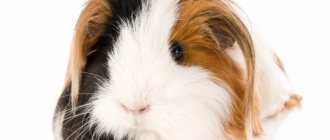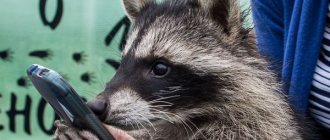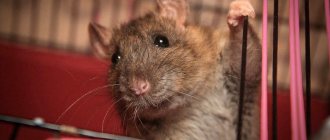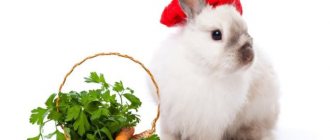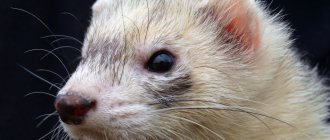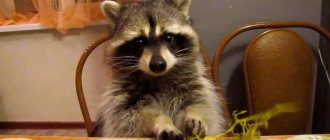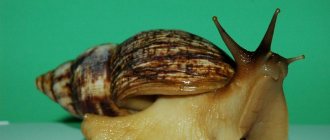Domestic rabbits are adorable, furry animals that not only kids, but also their parents love. Decorative rodents love the company, attention and affection of their owners.
When purchasing an ornamental animal, many people wonder how many years do rabbits live? Everyone who dreams of having a furry pet at home wants to prolong the joy of communicating with him, which requires finding out his life expectancy and what conditions are necessary for him.
Life expectancy at home
There are a number of factors that determine how long rabbits live . Among the key ones, the following should be highlighted:
- Hereditary characteristics. The maximum age of a pet is greatly influenced by its pedigree. The breeder must ensure a competent breeding process, monitor the purity of mating and separate families in a timely manner. In this case, the offspring will be strong and resistant to diseases.
- Immune system and breed diseases. The quality and life expectancy of pets depends on the timely administration of vaccines and the prevention of all kinds of diseases. Decorative breeds need to be vaccinated with universal drugs, since they are constantly in contact with people and become vulnerable to viral or hemorrhagic pathologies. A good vaccine provides comprehensive protection against rabies, paraphyte, pasteurellosis and other dangerous manifestations.
- Care and care. Even after all vaccinations have been completed, domestic rabbits can be exposed to dangerous infections and die en masse. If the animal’s condition worsens, it is important to immediately begin to deal with the problem, preventing it from developing. Any lethargic behavior, abnormal condition or strange symptoms should prompt the owner to go to the veterinarian for help. This factor greatly affects the lifespan of cute animals.
- Climatic conditions. Rabbits are highly dependent on the microclimate in the room where they live. The installation of heating radiators and air conditioners has a detrimental effect on their health. To avoid deviations from normal temperature conditions, it is important to place a thermometer in the barn or rabbitry and monitor the readings. For outdoor varieties, it is necessary to provide protection from direct rays of the sun and frost. It is better to clarify all the details of care with the breeder.
- Personal space. Like other decorative creatures, rabbits require free space to move around. Such a space needs to be properly arranged and made bright, since any restrictions worsen the well-being of the animals. Ornamental species can roam freely outside on the lawn, but under strict supervision. They can also be let out for walks in the house.
Animal lifespan
The average lifespan of animals varies depending not only on the type of animal, but also on other factors such as whether they live indoors or outdoors and the level of medical care provided by their owners. Popular pets such as cats and dogs usually live for about 10-12 years, which means that the child who receives the pet will have to experience death during childhood.
A pet's life can be extended if it is properly cared for. Proper nutrition, suitable habitat and quality veterinary care can significantly increase the life expectancy of an animal.
Dogs
Each dog breed has its own life expectancy. Breeds such as the Irish Wolfhound, Bulldogs and Bernese Mountain Dogs have an average lifespan of six or seven years. At the other end of the spectrum are breeds such as Bedlington Terriers, Toy Dachshunds and Poodles, Tibetan Terriers and Whippets, which have a lifespan of around 14 years. There is no maximum age for lifespan, and many dogs can live for 20 years or more.
Cats
For cats, the main factor that determines life expectancy is whether they live indoors or outdoors. Outside the home, cats usually only live for four or five years because they are more likely to catch viruses or get injured. Domestic cats typically live 12-18 years.
Birds
Birds typically have a lifespan of 10-30 years. Parrots - cockatoos, macaws and cockatiels - tend to live longer. These birds can live up to 70 years or more.
| Life expectancy of pets | ||
| Animal | Average number of years | Maximum (long-lived) |
| Dogs | 12 | 29 |
| Domestic cats | 12-18 | 34 |
| Horses | 20 | 62 |
| Cows | 20 | 35 |
| Goats | 15 | 18 |
| Sheep | 8-16 | 20 |
| Rabbits | 5-15 | 18 |
| Hamsters | 3 | 10 |
| Rats | 2-3 | 4 |
| Mice | 3-5 | 6 |
| Lizards | 4 | 8 |
| frogs | 4-15 | 21 |
| Pigeons | 20 | 35 |
| Owls | 30 | 80 |
| Crows | 15 | 80 |
| Cockatoo | up to 70 | 70 |
| Sparrows | 15-20 | 23 |
| Goldfish | 5-10 | 41 |
| Crocodile | 13-14 | |
| Eagle | 80 | |
| a lion | 35 | |
| King penguin | 25-28 | |
| Python | 20 | |
| Zebra | 30 | |
| Indian elephant | 70 | |
| Chimpanzee | 50 | |
| Beaver | 20 | |
| Arctic whale | 190-200 | 211 |
Many people, when a pet rabbit appears in their home, have questions about how long it will live.
The important fact remains that what breed he has is completely insignificant, the main thing is care, feeding, lack of stress, walks, space and love for the pet.
As for rabbits in a homestead, the main thing is a large amount of space and a lot of air.
It is also worth bringing light into the cages for the full development of the rabbit, since it needs to receive light illumination for about 10 hours a day.
Balanced feeding
When figuring out how to raise rabbits and how many years these creatures live, it is important to pay attention to feeding issues. Food is prepared using a special technology in compliance with the diet. Even a novice farmer should adhere to the following recommendations:
- The daily menu should include finely chopped pieces of beets, carrots and apples. Boiled potatoes are given to animals in small quantities.
- An irreplaceable component of the diet are cereals and legumes. The rabbits are also given corn and oats.
- In the evening, pets are fed with special store-bought mixtures in a volume of 2 tbsp. l. per one individual.
- To saturate the body with beneficial vitamins and minerals, pressed chalk is added to food.
- The daily diet should be divided into 6-7 equal portions. In the morning, the animals are fed with hay, and after 1.5-2 hours with cereals. After another 2-3 hours, feeding vegetables is allowed. The next portion includes grass and legumes, and the last one is based on a special feed. Combining different types of food at one time is prohibited.
Since the rabbit is a herbivore, it needs to be constantly given hay or fresh grass. This could be alfalfa, nettle, burdock leaves, dill or dandelion. It is better to collect plants in the afternoon, giving preference to grass from the countryside.
This form of nutrition can be practiced in winter and summer. It is suitable for a variety of ornamental and meat breeds, including iceberg and dwarf lop rabbit ram.
Conditions for longevity
If you want your furry pets to please you with their health for a long time, when choosing a rabbit you need to take into account its genetic inclinations and predisposition to longevity. In the future, everything will depend on you: what conditions you will create for him and what you will feed him.
Genes
Almost all domestic rabbits have a high life expectancy, but when choosing young animals, it is important to contact only professional breeders who keep completely healthy pets. When choosing an animal, be sure to look at its parents and evaluate their condition, because only strong representatives of the breed can produce good offspring.
In some cases, you can purchase an animal from your own hands, but this way you have little chance of getting reliable information about the baby’s ancestors.
Important! Carefully study all the features of the exterior of the chosen breed, because if you want a lop-eared representative, and they sell you a straight-eared rabbit, in the future this may serve as a reason for frustration, even despite the fact that all such fluffy animals are very cute.
Conditions of detention
The second important factor that directly affects the life expectancy of a rabbit is where exactly and how it lives. Thus, even representatives of long-lived breeds need comfortable living conditions, which means that dwarf breeds should also have a spacious cage
It is also important to provide your pets with regular walks lasting at least one hour. If possible, take the animal outside so it can run around on the grass.
But children should not be allowed to carry a rabbit in their arms for a long time, cuddle it and use it as a living toy.
Try to ensure that the animal does not experience stress, for which purpose the environment in the house should be as calm as possible. This requirement especially applies to owners of decorative breeds, since even a sharp clap can cause heart failure in such animals.
Regular cleaning of your furry pet’s permanent home is also required. Every day, leftover food, droppings and stray bedding should be removed from the cage. Make sure there is clean water in the drinking bowl. A cage with decorative rabbits, as well as with ordinary ones, should be placed away from drafts and scorching sun, because animals are equally harmed by both hypothermia and overheating.
By creating optimal living conditions for animals, you will protect them from diseases, which means that nothing will interfere with the genetic inclinations of a long-liver.
Important! If you notice that your pet's eyes have become cloudy, he is lethargic and refuses food, you should not delay a visit to the veterinarian.
Nutrition
If you are not raising rabbits as a source of meat, but are more interested in raising a healthy pet, then you should not overfeed the animal. As long as your pet rabbit lives with you, he should receive only balanced food, with all the vitamins and microelements his body needs.
A constant excess of food will quickly lead to excess weight gain, and as a result, problems with the cardiovascular system may begin, shortness of breath will appear, the body's resources will quickly wear out, which also affects the ability to reproduce offspring.
Your pet rabbit's diet must include cereals, herbs and various vegetables, and tree branches. Of course, if you are interested in gaining weight for your animal, then you can not limit the amount of these products by adding even more nutritious food to them.
Find out more about the benefits or harms of hay, burdock, and nettle in a rabbit’s diet.
Signs of aging
Knowing what an ordinary and decorative rabbit looks like and how many years it lives, you can easily determine the first signs of aging . In most cases, the process is accompanied by the following phenomena:
- The coat begins to thin out regardless of the presence of shedding.
- Tasty treats do not bring joy to the animal.
- The desire to play, run on the lawn and eat fresh plants disappears.
- There is no characteristic shine in the eyes.
- The skin in the abdomen begins to sag. The problem occurs more often in female rabbits than in female rabbits.
However, the listed signs are not always associated with natural age-related changes. Sometimes they are symptoms of a dangerous disease. If a rabbit appeared in the house a couple of days ago, it is better to consult with specialists from a veterinary clinic and tell him about the problems that have arisen. After comprehensive treatment and assessment of care features, your health will improve.
How to extend the life of a rabbit
The lifespan of rabbits largely depends on the care of the owner. If animals are kept in a large enclosure or pit, it is very difficult to control their reproduction and lifespan. In the absence of control on the part of the owner, the number of lambings per female can be 8 times per year.
Separate keeping of females and males, strict control of mating, provision of proper nutrition and quality care can extend the life of pets to almost 9 years.
At 3-4 years of age, it is already necessary to be more attentive to the animal. Provide your rabbit with additional vitamins and regulate its diet so as not to harm its health.
At the same time, animals need to be provided with spacious premises so that they can run and jump. With a sedentary lifestyle, rabbits begin to develop health problems: obesity begins, the gastrointestinal tract functions poorly
It is important that animals always have clean water
Recommendations for extending the life of rabbits:
It is necessary to buy rabbits from nurseries with a good reputation.
It is important that the future pet has good heredity. Promptly prevent infection by various parasites. Vaccinate rabbits from the first days of life, following vaccination schedules. Keep animals in warm and dry rooms without drafts
In the summer, cover the cages to prevent the rabbits from overheating. Animals need to be provided with space for physical activity. Pets must be walked under personal supervision in the house or outside. Protect animals from stress. Babies should not be picked up and carried to other places frequently. The rabbitry should be located away from noisy objects. Change food and water for rabbits regularly. Periodically wash the dishes, clean the cages and add dry bedding. Keep animals in spacious cages.
Extension methods
If a meat rabbit or hare appears in the house, the owner will have one goal in mind - to get fresh meat and skin as quickly as possible. In this case, life expectancy will depend only on the preferences of the breeder.
As for decorative varieties that are grown as pets, on the contrary, they want to be protected from premature aging and death. There are a number of conditions to avoid rapid age-related changes and help rabbits live as long as possible.
First of all, you need to protect them from possible injury. To do this, rabbit homes are completely cleared of sharp and cutting objects, and the locks are made of the highest quality possible so that the pet does not fall out of the open door and get hurt.
Fresh and high-quality food is used as feed. It is better to feed rabbits using special drinkers. The animal will not be able to turn the container over and wet the fur.
Houses, bedding and food and water facilities must be clean. Bedding and drinking fluid are changed every day. You also need to regularly clean the cell of waste products to prevent the problem of the development of dangerous microorganisms and bacteria. When cleaning, it is forbidden to make loud noises, otherwise the pets may become very frightened.
From time to time, comprehensive disinfection of the cell should be carried out. The event is also mandatory before the upcoming birth. Surfaces are treated with ordinary chlorine-based “Whiteness”, which is used for washing.
It is necessary to take care of a balanced daily routine. It is better to take street walks before noon, since during this period furry creatures experience a peak in physical activity.
Animals love to play and frolic a lot, so they should have access to a spacious play area. There should be toys that can be chewed with your teeth.
Rabbits are curious creatures that love to search for tasty treats and explore new things. If they get bored, this will lead to severe depression and the development of diseases. The role of toys can be played by two-layer cardboard boxes with paper pendants.
Content
For a long, happy life, the little rabbit will need space.
Don't keep him in a cramped cage. To avoid unnecessary stress, do not place your pet's home near a source of noise or bright light. Avoid drafts and elevated temperatures Handle the animal carefully, do not allow it to fall from a height and do not suddenly pick it up
Animals, even the brave fold-eared variety, are afraid of noise, strangers and animals (cats, dogs). It happens that rabbits die of fear. To avoid testing the delicate nervous systems of dwarf varieties, do not allow other occupants of the home to frighten or disturb them. Explain to children that rabbits do not like to be cuddled or disturbed.
Life expectancy is associated with physical activity. Let your pet out of the cage at least a couple of times a day for an hour or two. Otherwise, your pet will have problems with:
- digestive system;
- overweight;
- heart, liver.
If you let the animal roam around the room, make sure that there are no wires from electrical appliances on the floor. Rabbits also chew other objects that they come across: the legs of chairs and tables, which leads to poisoning or clogging of the stomach. Seal cracks and holes in the floor to prevent your pet from climbing in and suffocating.
A harness is a must when going outside
If you take him outside, don't forget the harness and leash. Stray cats and dogs are a danger, so make sure they are not nearby. Do not walk animals in polluted areas or in bad weather.
Connections with relatives also play a role. Rabbits are sociable animals. If they are kept in pairs, then the chances of prolonging their existence increase.
Age of different breeds
The lifespans of representatives of different breeds vary greatly. Thus, a lop-eared pet lives much longer than a wild one, and albinos age and die faster than ordinary gray rabbits. To understand how long rabbits live, it is important to consider the following breed characteristics:
- New Zealand. They are characterized by good health and resistance to extreme temperature environments. Life expectancy reaches 5-10 years if the rules of maintenance and feeding are observed.
- Silver. The breed is distinguished by its unpretentiousness to living conditions and good health. Individuals live 7-10 years.
- Burgundian. They are famous for their strong immune system and resistance to diseases of the digestive system, which often destroy representatives of other breeds. The lifespan is 9−10 years.
- Belgian. They grow to large sizes and gain 5-5.5 kg of weight. They are particularly mobile, so they are not suitable for home growing. The diet of such animals should include hay and dry food. They live no longer than 5 years.
- Strokachi. They have good immunity and are not afraid of frost. Their weight is 10 kg and their maximum age is about 7 years.
- Dutch. Representatives of this breed weigh no more than 3 kg, have soft coats and live a maximum of 3-10 years.
How long do wild rabbits live?
The lifespan of wild rabbits is short and ranges from one to two, or at most three years. However, it is important to remember that in the wild, rabbits generally do not die of old age. The causes of their mortality are:
- diseases and parasites;
- hunger;
- predatory animals;
- hunters;
- bad weather conditions.
Hypothetically, a wild rabbit placed in a comfortable environment is able to live longer, but in practice, a change of environment often results in severe stress for the animal, after which it, again, dies. In rare cases of successful adaptation, the average lifespan of a rabbit removed from the wild is approximately seven to eight years .
Since such cases are rare, you should not try to replace decorative rabbits with wild ones - this does not make the animals any better.
Fold rabbits have a good nervous system
Possible diseases
If the rabbit is in good health, he does not refuse food and demonstrates high activity. At the same time, the coat has shine and remains pleasant to the touch. In the event of the development of any diseases, the following manifestations are possible:
- Interest in favorite treats disappears.
- The functioning of the digestive system deteriorates, and animals experience diarrhea or vomiting.
- The rabbit becomes lethargic, and the surface of the fur begins to gather in lumps.
- Breathing quickens.
- Body temperature rises.
- Signs of swelling appear in the eye area and mucus accumulates.
The nature of most diseases is associated with intestinal disorders. They develop when the diet is disrupted or spoiled food is eaten. The rest of the diseases appear due to non-compliance with maintenance rules and poor care.
The most common diseases discussed on forums include the following pathologies:
- Rickets. It occurs due to a deficiency of vitamins and minerals, and rare walks in open space. Symptoms include inflammation of the gastrointestinal tract, curvature of the spine and limbs.
- Conjunctivitis. Accompanied by the appearance of swelling in the eyelid area and copious mucous or purulent discharge from the eyes.
- Inflammation of the lungs. Symptoms include wheezing, mucus from the nose and high body temperature.
- Pododermatitis. Sores form on the lower surface of the paws, and the rabbits begin to quickly lose weight.
Infectious diseases develop against the background of contact with cutaneous pathogens . Among them:
- Myxomatosis. Tumors appear on the skin, ears droop, and the mucous membranes of the eyes begin to become inflamed.
- Rhinitis. Pus and mucus are released from the nasal sinuses, the rabbit sneezes heavily and suffers from diarrhea.
- Infectious stomatitis. When affected by this disease, the rabbit's lips and tongue turn red. A white coating also forms and intense salivation begins.
At home, pets are often exposed to respiratory infections and intestinal disorders. As a preventive measure, it is important to monitor your pet's hygiene and undergo regular medical examinations. Containers for food and water must be constantly cleaned and rinsed with boiling water. Old food should not be kept in the cage for more than a day.
Averages
Fold rabbits are popular and are often purchased to keep at home. Decorative pets of fold-eared breeds are very playful, they do not conflict, on the contrary, they love to communicate. They have a strong body, the back and chest are expanded. The ears hang down, the muzzle is small.
Fold-eared rabbits live longer than breeds with upright ears. The average life expectancy can be considered 8-9 years. There are cases where pets lived up to 13-14 years. Such fold-eared animals are called long-livers.
Another variety is standing-eared rabbits. They quickly get used to the tray, respond to nicknames, and recognize members of the household. When using a leash, they can be walked.
Decorative rabbits are compact in size and do not take up much space, and therefore these pets can be kept in a small apartment. The weight of the largest individual can reach 1.6 kg. Animals of medium size have a mass of 1.1 - 1.4 kg.
Vaccination
To extend the life of a rabbit, you need to give it comprehensive vaccination. Particular attention should be paid to vaccination against myxomatosis and viral hemorrhagic disease. In most cases, these pathologies lead to death - the death of the pet. The first vaccine is administered at the age of 1.5 months, and the second at four months of age.
Even if a pet does not come into contact with other animals and grows up at home, it can become infected from mosquitoes, fleas and contaminated objects.
Even eared creatures are often affected by worms. If you do not provide them with effective protection from parasites, fertility rates will be reduced and the condition of internal organs will deteriorate. Rabbits are afraid of round and tapeworms, so at the age of 3 months they will need comprehensive prevention. It is done using special tablets. If decorative mini-rabbits are not castrated, they may develop cancer, depression and nervous disorders.

